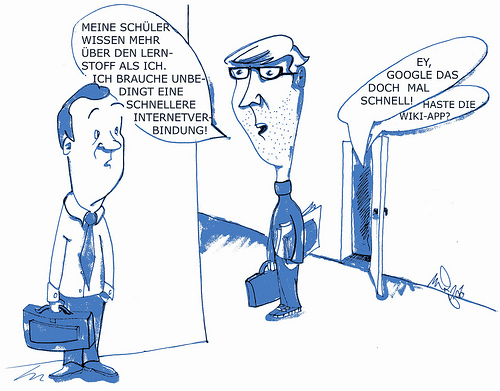Now the Table of Content and the abstract of my submitted thesis for the second doctorate (in german: Habilitation) at Graz University of Technology is online available. Due to the fact that the work is a cumulative one (a combination of 24 conference papers or journal articles) the originals can be already found on my webpage or as blogpost. Nevertheless if anyone is interested to get the whole file (it’s just a big one) contact me (martin.ebner [at] tugraz.at).
Merry Christmas and Happy New Year to all 🙂
[presentation] Konzept/Architektur von modernen Lernumgebungen
Ohne große weitere Kommentare, mein gestriger Habiliationsvortrag zum Thema „Konzept/Architektur von modernen Lernumgebungen“ – hoffe man kann die vielen Gedanken gut nachvollziehen:
[L3T] … wünscht eine frohes Fest
Wir freuen uns auch einen kleinen Beitrag zum heurigen Adventskalender auf e-teaching.org geleistet zu haben – viel Spaß wünscht auch das L3T – Team.
[L3T] Zwischenstand
Ein kurzer Zwischenbericht zum L3T-Projekt: Die meisten Reviews der überarbeiteten Artikel sind eingegangen und wir arbeiten nun fieberhaft bei den freigegebenen am Layout / Lektorat. Also es ist noch allerhand zu tun, aber wir sind trotzdem guter Dinge es doch einigermaßen voran zu bringen.
Nochmals möchten wir aufrufen uns Bilder oder Cartoons zu schicken bzw. in die Flickr Gruppe hochzuladen und uns bei Miriam bedanken, die einen solchen extra für das Projekt erstellt hat – DANKE:

[publication] Nintendo Wii Remote Controller in the classroom. A report on the Development and Evaluation of a Demonstrator Kit for e-Teaching
Our publication about „Nintendo Wii Remote Controller in the classroom. A report on the Development and Evaluation of a Demonstrator Kit for e-Teaching“ is now published in the Journal Computer and Informatics.
Abstract:
Increasing availability of game based technologies together with advances in Human–Computer Interaction and Usability Engineering provides new challenges to virtual environments for their utilization in e-Teaching. Consequently, a goal is to provide learners with the equivalent of practical learning experiences, whilst, at the same time, supporting creativity for both teachers and learners. Current market surveys showed that the Wii remote controller (Wiimote) is more wide spread than standard Tablet PCs and is the most used computer input device worldwide, which, given its collection of sensors, accelerometers and Bluetooth technology, makes it of great interest for HCI experiments in the area of e-Learning and e-Teaching. In this paper we discuss the importance of gestures for teaching and describe the design and development of a low-cost demonstrator kit for the Wiimote in order to demonstrate that gestures can enhance the quality of the lecturing process.
Reference: Holzinger, A.; Softic, S.; Stickel, C.; Ebner, M.; Debevc, M.; Hu, B.: NINTENDO WII REMOTE CONTROLLER IN HIGHER EDUCATION: DEVELOPMENT AND EVALUATION OF A DEMONSTRATOR KIT FOR E-TEACHING. – in: Computing and informatics (2010) 29, S. 1001 – 1015
[podcast] u-Learning? Future of Education from a technical perspective
Im Rahmen der 2. Zukunfstwerkstatt des Forum Neue Medien Austria durfte ich das Impulsreferat rund um das Thema „u-Learning? Future of Education from a technical perspective“ halten. Die Folien sind bereits hier veröffentlicht, jetzt folgt noch der VodCast auf iTunesU.
Weiters gibt es hier eine kleine Nachlese der gesamten Veranstaltung.
[presentation] e-Learning X.0
Im Rahmen der Vorlesung „Gesellschaftliche Aspekte der Informationstechnologie“ an der TU Graz halte ich heute diesen Vortrag rund um das Thema „e-Learning X.0„. Neben einer Aufarbeitung des derzeitigen Forschungsstand am Gebiet von Technology Enhanced Learning, versuch ich mich auch etwas in zukünftigen Entwicklungen:
Wer mich auch hören möchten, kann dies ab 17.00 Uhr hier [Livestream TU Graz] tun.
[podcast] e-Learning, Lernen heute/morgen
Die Aufzeichnung meines Workshops im Rahmen des 30. Österreichischen Bibliothekertag rund um das Thema „e-Learning, wie lernen wir heute oder auch morgen?“ ist nun verfügbar.
Die Unterlagen in Form eines frei zugänglichen eBooks sind bereits hier veröffentlicht.
[video] Learning in Today’s World
Also dieser Film zeigt es wieder mal: das Lernen von heute führt wohl nur über Apple 🙂 – Spaß beiseite, ich denke hier werden ein paar schöne Möglichkeiten gezeigt:
(danke an Rene)
CfP TELSci2.0
I am very glad to announce the 1st Workshop on Web2.0 approaches, tools and technologies to support research on Technology Enhanced Learning (TELSci2.0) at the 4th European Conference on Technology Enhanced Learning (EC-TEL09), Nice, France, September 29 – October 2, 2009
This workshop aims to bring together all those who want to turn a vision of the e-scholar and e-scientist of the 21st Century into reality in our own domain of TEL.
The core of significant development in a „2.0 world“ is
- leveraging web2.0 technologies (that rely on the „social graph“) for improving the effectiveness and efficiency of how we conduct science;
- the capacity to share and reuse data, and to benchmark scientific activity in the international community.
Key questions for this workshop include:
- How do we mesh social web2.0 technologies with the scientific workflow?
- How do we share the data of our activity wider in our community?
- How do we visualize that data and how do we provide researchers with powerful new frameworks for their scientific endeavor?
Please find more here or at Erik’s Weblog.
